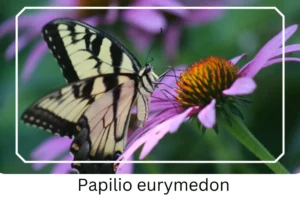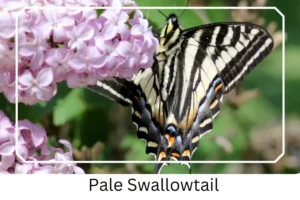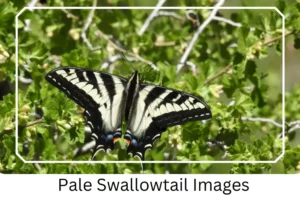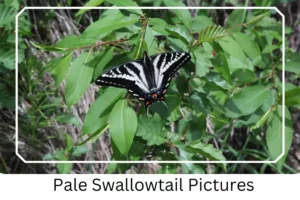Pale Swallowtail (Papilio eurymedon)
The Pale Swallowtail butterfly, scientifically known as Papilio eurymedon, is a captivating species belonging to the swallowtail group, native to the western parts of North America. Renowned for its striking black-and-white patterns and elegantly pointed wings, this butterfly is a sight to behold in its natural habitat. Often found engaging in puddling behavior on moist soil, it’s a fascinating subject for both amateur naturalists and professional entomologists.
Scientific Classification
- Family: Papilionidae
- Genus: Papilio
- Common names: Pallid Swallowtail
- Scientific Name: Papilio eurymedon
Overview
This comprehensive guide delves into the life cycle, characteristics, and behaviors of the Pale Swallowtail butterfly. From its early days as a caterpillar to its majestic flight as an adult, we uncover the intricate details that make this species unique. With a focus on easy readability and enriched content, our aim is to provide a thorough understanding of the Pale Swallowtail, enhancing appreciation for one of nature’s remarkable creations.
Description and Identification
Caterpillar
The journey of the Pale Swallowtail begins as a caterpillar, reaching up to 5 cm in length. Initially, they sport a vibrant green color, adorned with peculiar eye marks designed to ward off predators. As they mature, their color transitions to tan or reddish, signifying their readiness to metamorphose into a pupa.
Pupa
The chrysalis phase reveals a pupa either pale olive green or light brown in color, skillfully hanging from the branches of its host plant with silk threads. This stage can include a period of hibernation during winter, depending on the seasonal timing.
Adult Butterfly
Sexual Dimorphism: This species exhibits no sexual dimorphism, making males and females visually indistinguishable.
Color and Appearance: The adult Pale Swallowtail is a vision of elegance, with creamy or off-white wings adorned with four parallel black stripes. The unique shape and the twisted tail-like extensions on the hind wings add to its distinct appearance. Both sides of the wings feature thick black borders and subtle orange and cyan markings, presenting a mirror image when closed.

 Average Wingspan: The wingspan ranges from 3.5 to 4.5 inches (8.9 to 11.4 cm), allowing for moderate flight capabilities.
Average Wingspan: The wingspan ranges from 3.5 to 4.5 inches (8.9 to 11.4 cm), allowing for moderate flight capabilities.
Flight Pattern: Their flight is characterized as moderate, with a graceful and controlled movement through the air.
Additional characteristics worth noting include the butterfly’s adaptability and resilience across various stages of its life cycle.
Eggs
The eggs of the Pale Swallowtail are green or tinged with reddish hues, laid individually on the leaves of host plants, marking the beginning of the life cycle.
Quick Facts | |
| Distribution | Extends across the western part of North America, from British Columbia to Montana, and down to southern New Mexico, California, and Baja California. |
| Habitat | Prefers sunny foothills, shrubby forest areas, open woodlands, and stream sides. |
| Host Plants | Utilizes trees and shrubs in the Betulaceae, Rhamnaceae, and Rosaceae families, including cherry, coffee-berry, and ash. |
| Adult Diet | Feeds on nectar from various flowers such as wallflower, California buckeye, and yerba santa. |
How to Identify Pale Swallowtail?
Identifying a Pale Swallowtail butterfly involves looking for specific markers that distinguish it from other species. The adult butterfly’s creamy or off-white wings, adorned with black stripes and unique tail-like extensions, are key identifiers. Observing the butterfly’s flight pattern, which is moderate and graceful, along with the distinctive color patterns when the wings are both opened and closed, can aid in identification. Additionally, the presence of small orange and cyan markings on the rear wings serves as a visual clue. When attempting to identify the caterpillar stage, look for the green color with eye marks, a feature designed to deter predators. Spotting these characteristics in their natural habitats, such as sunny foothills and open woodlands, further confirms their identity.
Did You Know?
- The Pale Swallowtail butterflies participate in what are known as “puddling parties,” where males congregate in large numbers to ingest minerals from moist soil. This behavior, which sometimes includes other butterfly species, is crucial for their mating success.
- Another fascinating fact about these butterflies is their adaptation to various host plants, showcasing an impressive level of ecological versatility that allows them to thrive in diverse environments.
Conclusion
The Pale Swallowtail butterfly embodies the beauty and complexity of the natural world. Through each stage of its life cycle, from the green caterpillar with its defensive eye marks to the elegant adult with its distinctive wing patterns, it captures the imagination of those who observe it. By understanding and appreciating these creatures, we deepen our connection to the intricate web of life that surrounds us.
Pale Swallowtail Pictures

Scientific Classification

- Family: Papilionidae
- Genus: Papilio
- Common names: Pallid Swallowtail
- Scientific Name: Papilio eurymedon







